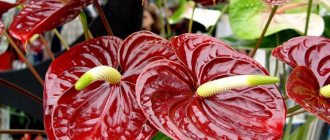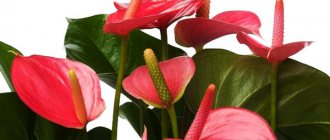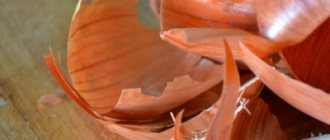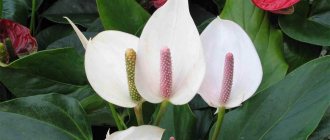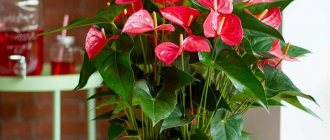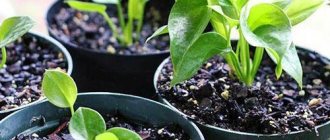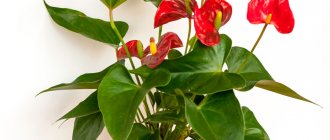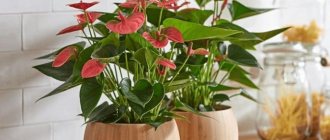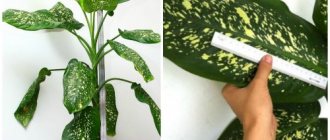Let's consider the most popular indoor flower among its species, Anthurium andreanum. White anthurium Andre, or anthurium andrianum red, takes first place in popularity, but this does not mean that other varieties are not worthy of attention. It has gained popularity and respect among other indoor plants due to its elegance and beauty of inflorescences. As soon as flower growers do not call it, translated from Greek it is a tail and a flower, you can find such names as wax flower, male happiness - it is believed that it brings happiness to the groom and prosperity in family life, flamingo flower. Anthurium - belongs to the Araceae family.
Description of the plant
Anthurium Andre (Andrianum) is a genus of evergreen, perennial, belonging to the Araceae or Aronicaceae family, native to the tropical regions of South America.
Grows naturally in the tropical forests of Ecuador and Colombia. There it was nicknamed “fire tongue” or “flamingo flower”. In Latin it sounds like Anthurium Andreanum, the name comes from the Greek words for “tail” and “flower”. And here we call it “men’s happiness” or “flower of love.” The highlight of Andre's decor is the bracted sheet-spread, spread around the inflorescence-cob. The blanket leaf is the same as the heart-shaped leaves, but is distinguishable by its structure and color. There are several varieties with different shades from white to black, but the most famous ones are bright scarlet.
All parts of anthurium contain toxic substances that are dangerous to humans and their pets. This fact must be taken into account when choosing places for its cultivation (remote from children and pets)
Care for the flower with care.
Characteristics of a plant with red and other bracts leaves
- Type : epiphytes (presence of aerial roots).
- Flower/fruit color : bracts are found in nature only in red shades, but thanks to the efforts of breeders, varieties of all shades of flowers have been bred, from white to black. The cob itself is white to yellow, and the fruits are orange in color. Leaf color: from light green to dark green.
- Need for sun : loves bright, diffused sunlight, direct sunlight can cause burns on the leaves.
- Size : reaches 1 m in height.
- Flowering : Duration from 1 month to 1 year.
- Aroma : Has a seductive aroma.
Growing anthurium at home is a rather delicate process due to its capricious nature. The best way to maintain the viability of a flower is to prevent painful conditions, i.e., competent care. By following the recommendations given in this article, you will be able to properly care for it. And remember, any expenditure of labor and time will surpass the impeccable appearance of Andre’s anthurium.
Varieties
Let's look at some varieties of anthurium that are most popular.
Andreanum
Anthurium Andreanum has fairly large, greenish, heart-shaped leaves. And the plant itself is also large. The stems have a large number of aerial roots. Surface of various colors: snow-white, pink, scarlet, yellow and green.
Scherzerianum
Anthurium Scherzerianum is an epiphyte. Stems are shortened. It grows no higher than 40 cm. The leaves, like those of Anthurium Andre, have a leathery structure, but are covered with dark dots on both sides. As a rule, its inflorescences are taller than the plant itself. The surface is scarlet-red. Occasionally other colors are found.
"Andrianum Champion"
'Andrianum Champion' has large, leathery leaves. Its bract is modified. The bract itself comes in different shades. There is an inflorescence inside it. The cob is slightly curved. Depending on the variety, the color varies from white to black. May bloom throughout the year. The flower itself is red. It blooms for about three months. Maximum grows up to 65 cm.
Anthurium "Dakota" is very large in size, reaching a height of 80 cm. The size of the bedspread is up to 20 cm. The spadix is yellow.
Anthurium Andre "Baby Boomer"
Anthurium Andre "Baby Boomer" - for it you will need light, slightly acidic soil filled with minerals. Grows up to 90 cm. Blooms for 3 months. At home, it is better to keep it on the west or south side; sometimes it needs to be exposed to the sun, but not longer than 2 hours. Just like other varieties of anthurium, it needs abundant watering and maintaining high humidity in the room.
"Sierra"
Anthurium “Sierra” - if most varieties of this family are quite tall, then this variety is medium in size and will fit into any interior. The flowers have a passionate red color, the peduncle is quite large, yellow-green in color. Most often, it is chosen as a gift, not only for women, but also for men. If you properly care for Sierra, it will delight you with its flowering all year round.
Crysytallinum
Anthurium Crysytallinum - the leaves of this plant change from yellow-violet to green over the course of its life and do not grow more than 20 cm. Their velvety surface is shaped like a heart. You can see silver veins on it. This anthurium is called crystal not only because of such veins, but also because of the beautiful cover of purple or green color, reminiscent of this material in general.
"Fabulous"
Anthurium “Magnificent” is also often found among domestic species. It is somewhat similar to the previous species. This is a beautiful plant with large leaves of a velvety greenish color. There are snow-white veins on the leaves.
Anthurium Linden
There is also a rather unusual species of Linden anthurium. This species is found in the wild. Pink anthurium is rare, more often a rich green color. This species is native to Colombia. It often grows under trees or as an epiphyte on a tree. The key difference between the Linden anthurium is the shape of its leaves. They have the shape of a pointed heart and shine with gloss. The leaves are quite large. Sometimes their length reaches 30 cm. They also have olive-colored veins. The bract of the plant is pink and round in shape, pointed towards the tip of the leaf. On a peduncle about 40 cm in size there is a creamy white cob. When it blooms, it smells bright.
Anthurium Hooker
Anthurium Hooker can very rarely be found at home, only if somewhere in private collections, since this plant is still wild. It is found in the Lesser Antilles, in the tropical forests of Suriname, Trinidad and in some areas of Guiana. Leaves in the form of a rosette. The diameter of one such rosette is quite large, ranging from 150-200 cm and a height of slightly more than 50 cm. The stem is literally not visible. The leaves are large, elliptical, narrowed. If you look closely, you can see dark spots on the leaves. The petioles of the leaves are quite short, which also distinguishes this type of plant from the rest. It is quite difficult to grow Hooker's anthurium at home so that its cob can be seen. But if you manage to achieve this, you will see a large ear of dark purple color, about 30 cm high, with a bract slightly shorter than the inflorescence itself.
Transfer
Prepare a new pot with drainage holes and fill it with soil.
Before transplanting, water the flower thoroughly, then the soil will be softer and the root will be easier to remove from the container. If you have a plastic pot, you can lightly tap it on something hard.
Afterwards, the anthurium is removed, inspected and placed in a new pot.
Important! Replanting is required if roots are visible from the drainage holes and on the soil surface. It is better to choose a pot that has the same height and diameter.
If you transplant a flower into a pot that is too spacious, you will wait a very long time for the anthurium to bloom, since it will not form flower buds until the roots grow into the new soil.
After transplanting, the flower is watered again, and sphagnum moss is sprinkled on top.
Reproduction
There are many ways to propagate anthurium, so everyone can choose the one they like or find simpler.
Growing from seeds
A fairly popular method of propagating a flower is growing from seeds. Seeds are purchased in specialized stores. Before sowing, they are treated with any growth stimulator for ornamental flowering plants. The treated seeds are sown in small containers with a mixture of peat and perlite in grooves to a depth of 2 cm, maintaining a distance of 4 cm between each seed. They are then sprinkled with substrate and sprayed with warm water from a spray bottle.
The container is covered with a transparent film on top and placed on a light window. When germinating indoors, maintain a temperature of +25°C, ensure there are no drafts and sufficient lighting while maintaining a 12-hour daylight hours. You can extend daylight hours by installing a fluorescent lamp next to the container, which must be turned on when it gets dark outside.
Every day the container must be freed from the film for 1 hour for ventilation. The soil is sprayed 2-3 times a week as the top layer dries.
After the first shoots appear (seeds germinate within a week after sowing), remove the film from the container and continue care. When each plant has 3 leaves, they can be transplanted into separate plastic cups. As a substrate for replanting, use a mixture of sphagnum and soil for azaleas, provide good drainage (expanded clay) and make holes in the bottom of the glasses so that excess water leaves the container.
In the process of growing young plants, they are watered every week with water containing “Kornevin” and sprayed with “Epin” according to the instructions.
Dividing the bush
Anthurium is often propagated by dividing the mother bush during the process of replanting the plant. To propagate using this method, carefully remove the plant from the pot and shake off the soil, freeing the root system.
Try to unravel tangled roots carefully so as not to damage them
Using a sharp and clean knife, divide the root into 2 parts. Cut areas and damaged roots are treated with crushed activated carbon. All obtained parts of the plant must be planted in separate pots, following the recommendations for replanting the plant.
After replanting, you do not need to water the plants immediately - let the cuttings dry a little and heal. The first watering can be done a week after planting.
We recommend reading how to properly plant indoor flowers in a pot.
Cuttings
Anthurium propagation in this way is practically not used due to the fact that cuttings placed in water for root development often rot.
If you decide to propagate anthurium by cuttings, the most favorable time for this is from May to June
When choosing, pay attention to the apical stems up to 15 cm in length: they should have 2 leaves. Cut such a cutting, maintaining the maximum length
It is better to root cuttings in vermiculite: it is poured into plastic cups with a pierced bottom. Due to the high flowability of this substance, a piece of cloth capable of retaining vermiculite is placed at the bottom of the glass. The cuttings are buried 5 cm into the soil, then watered generously with warm water. The cuttings will take root for at least 30 days, after which the plant is planted in a pot, using the soil as for replanting.
By shoots
Aerial roots often appear on anthurium, so they, together with shoots, are used to propagate the plant. To do this, stem shoots with aerial roots are separated from the plant with a sharp, clean knife. The sections are sprinkled with crushed coal, and parts of the plant are rooted in a container with river sand.
A transparent plastic bag is placed over each container. The greenhouse is regularly ventilated, the soil is sprayed with warm water from a spray bottle. When the plants develop additional roots and active growth of green mass occurs, they are planted in pots with a soil composition as for replanting.
How to propagate
- Reproduction. Anthurium Andre reproduces well in all possible ways, some more difficult and longer, some easier. Let's look at these methods of reproduction. As you know, plants can be propagated through seeds, cuttings, dividing the bush, layering or rooting leaves. As you remember, an adult plant can be replanted once every five years, so when replanting it’s time to divide the bush, we do it carefully and try not to break the roots. When propagating by cuttings, you can get flowering faster than by growing seeds; the latter method will give flowering only in the 3rd year. When dividing an adult bush, if necessary, use a knife; in order to cut the plant, the knife must be sterile, and the cut should be treated with ash or coal. When dividing the plant, try to ensure that each part has a sufficient number of roots for further growth and development of the plant. When cutting, the upper part of the shoot is taken and rooted in a separate pot with soil mixed with peat. We monitor soil moisture and avoid overwatering. Reproduction through seeds is a rather lengthy method, for this you need to pollinate the inflorescences, wait for the seeds to ripen and collect them (they will ripen about a year after pollination), sow the seeds in moist soil and keep them at a temperature of 25 degrees, as soon as the shoots appear, we dive them in three stages, the last transplant should be made into a permanent pot. Lateral shoots can also be used for propagation; flowering will occur within a year after planting. rejuvenate the plant when the plant has lost its decorative properties. To do this, we use the cutting method, cutting off the shoots, the remaining part of the plant will produce lateral buds, and they will grow into new shoots, which can be left on the bush or also transplanted into separate pots.
What does Anthurium Andre look like?
Anthurium belongs to the Araceae family, which includes mainly vines, evergreens and epiphytes that do not require soil to grow fully. It is native to the tropical zones of Central and South America.
Anthurium Andre
If we talk directly about the characteristics of the plant itself and the Anthurium Andre variety in particular, it is worth noting the following points:
- The flower is a cylindrical rod covered with small fibers. But it is the bract that makes a bright impression - it is a fleshy, heart-shaped petal with a color ranging from white to black-violet.
- The plant blooms throughout the year, and this is especially evident when suitable conditions are created. Each peduncle retains its original appearance for 1 to 2 months, depending on the variety.
- With complete pollination, berries, including seeds, are formed in place of the flower.
- The leaf blades are quite massive - they reach 30 cm in length. The color is most often rich green with a glossy gloss.
Foliage of the plant
Common varieties
This home flower has thousands of varieties, but not all are grown at home. Most often used as interior decoration:
- Variety Leganza - a distinctive feature is that the color of the petal varies during flowering from pale pink to deep orange.
- Otazu - has dark red, almost burgundy bracts. They look quite contrasting against the background of a yellow flower.
- Silens is an interesting option in the form of bicolor. The flower has a yellow-red, uneven color. And the bract is white or cream with rich pink-beetroot veins.
- The largest hybrid is the Favorit variety. It features dark foliage and a bright pink spathe.
- Scherzer is an original variety whose flower ear is not straight, but sinuous. And the bedspread is lanceolate and matte.
Mix
Note! In addition, there are varieties whose stipules can be colored blue, purple, bright yellow, black, and green. Among the dark red varieties, Anthurium Andrianum stands out
Among the dark red varieties, Anthurium Andrianum stands out.
Popular Andre varieties
The plant is often planted for decoration in galleries and winter gardens. The multi-colored palette of bracts, spectacular shiny leaves and almost year-round flowering (and in some varieties, even year-round) will decorate any area of the interior or exterior.
One of the most common and popular varieties is Belize or “male happiness.” It is similar to the parent plant, but the bract is dark red, rich in color, sometimes with a green edge, and the inflorescence is yellow. It is believed that if you give such a flower to a lonely man, he will soon find his male happiness - his soul mate. Whole series of multi-colored Andrés have been created based on the mother flower:
- pink – Pink Champion, Pink Alabama, Jolie, Lady Love;
- orange – Madural Orange, Princess Orange, Baby Orange;
- red of different shades - Turenza, Sierra Magic, Dakota;
- purples, violet and lilac include: Picasso purple, Fiorino, Utah and Cavalli Purple;
- green ones look very unusual - Baby Green, Picasso green, Green King, Midori;
- yellow - again Picasso, only yellow, Vanilla, yellow Princess Alexia;
- black color was also introduced - Otazu, Black Beauty, Black Queen;
- white – Sumi, white Champion.
There are many mixed shades and two-tone anthuriums. Even blue varieties can be seen, although this color is artificially added to the root system: Picasso blue and Princess Alexia blue. You need to care for the plant the same way, regardless of the color you choose.
Reproduction
To turn your home into Andre's blooming abode, there is no need to spend money on a new planter. You can simply start propagating the culture. Read on to find out how to do this.
Cuttings
The easiest and most convenient way. It is better to carry out the procedure in spring or summer, since during these periods the cuttings take root and take root better. The first thing you need to do is cut off the top of the flower with several internodes, 5 cm long. Then place it in water and wait for the roots to appear. You can cut off the part already with the air root. The cuttings are planted a month after cutting. During this time, the roots of the seedling will reach a length of 3 cm.
Important! Yellowing of the edges of the leaves of the plant indicates aging, or lack of light. Therefore, you need to think about its reproduction or rejuvenation.
Growing from seeds
The procedure will be more complicated than the previous one and will require much more time and effort. After all, first of all, you need to wait for the Anthurium to bloom, for the fruits to set and reach. And for the fruits to appear, the pollination process must be carried out in the first days of the appearance of flowers. This procedure is carried out using cotton sponges or a brush, passing over the cob several times.
The best effect is obtained by cross-pollinating two or even more Andrés. A single procedure will not be enough; it must be repeated over several days. After carrying out pollination procedures, you need to be patient and wait until the berries, and then the fruits, ripen. The wait can last a whole year.
After the ripening period has expired, you need to collect the seeds, which can be planted immediately, having first cleared the berry pulp. Planting is the act of placing seeds on the soil. There is no need to cover them with the substrate from above; you just need to press them a little to the ground and then spray them with a spray bottle. The container is sent to a warm (+25…+28°C) and dark place. In just a week or two, the first shoots will appear.
After about 2 months, the sprouts will have 2 true leaves. This suggests that they need to be dived. Another pick is carried out after another 2 months. You can place seedlings in separate containers only when they have 5-6 leaves.
Important! Anthuriums grown from seeds will bloom only after 3 years.
Anthurium Princess Amalia Elegance
Number of blocks: 49 | Total number of characters: 43376 Number of donors used: 6 Information on each donor:
- https://glav-dacha.ru/foto-i-opisanie-sortov-anturiuma/: 5 blocks out of 8 were used, number of characters 5264 (12%)
- https://sadim.guru/samye-populjarnye-sorta-anturiuma-s-foto-i-nazvaniem/: 1 out of 2 blocks used, number of characters 9452 (22%)
- https://FlowersHoliday.com/anthurium-species-vidu-dlya-doma/: 4 out of 5 blocks used, number of characters 5563 (13%)
- https://proklumbu.com/komnatnue/vidy-anturiuma.html: 5 blocks out of 7 used, number of characters 5487 (13%)
- https://proogorodik.ru/samye-populyarnye-sorta-i-vidy-anturiuma.html: 3 blocks out of 5 were used, number of characters 4804 (11%)
- https://jubkiplus.ru/anturium-foto-katalog.html: 31 blocks out of 32 were used, number of characters 12806 (30%)
Video “Ways to maintain an atrium at home”
Experienced flower growers talk about the secrets of growing indoor plants.
Legend
It says that in ancient times, when people lived in tribes, one girl turned into a red anthurium. The cruel leader of one tribe took a fancy to a beauty from a neighboring one. He attacked the village and took it away. According to tradition, on the wedding day it was customary to light a fire, into which the young beauty threw herself, not accepting her lot. The gods took pity on the unfortunate girl, turning her into the luxurious red Anthurium Andre. And the bride’s home village became a beautiful tropical forest.
Since then, drops of moisture have flowed down the foliage and grass in it. They have become a symbol of the tears of inconsolable parents who mourn their daughter. The bright red anthurium is considered a symbol of love and has been growing since that time in the dense greenery of the tropics. Residents of Colombia believe that the flower can bring prosperity and happiness. This is what married couples use to decorate their homes on their honeymoon.
Description
Externally, Anthurium Andre is an evergreen and perennial shrub. It has a short stem, green elongated leaves with a shiny surface. Their standard length is 30, width – 12 cm. A feature of the leaf is its heart-shaped center. The petioles grow up to 30 cm. The spadix, in which the pale yellow flowers are collected, can reach a length of about 10 cm. The highlight of the image is the leaf-spread located near the inflorescence. It is wide and somewhat wrinkled, characterized by a heart-shaped shape and distinct veins on the surface.
Anthurium Andre has orange and round shaped fruits. Today, breeders have managed to develop many of its varieties. Each of them has a flowering duration from 1 month to a year, the color of the inflorescence leaf is green, purple, red, burgundy, brown, black or two-color. With proper care at home, the plant can survive for 3–4 years, after which it rejuvenates.
Popular varieties of Anthurium Andre are Champion - a plant with yellowish-pink inflorescences and a snow-white blanket on which pink veins are visualized; Lentini Pink - a crop with a greenish-pink veil; Otazu is a plant with a dark burgundy veil; Leganza - with a greenish-pink bedspread. Varieties of Red Anthurium are varieties Dakota - a plant with a spathe length of about 25 cm; Black Queen is a crop with a characteristic colored veil and light-colored inflorescences; Fantasy Love - with a three-color bedspread combining pink, white and green; Cavalli - with a blanket of delicate lilac color; Fiorino is a plant with a purple-pink shade of the bedspread; Utah - representatives of the Utah variety have an unusual bright pink bedspread.
Similar flowers
- Spathiphyllum cupido. The height of the flower is about half a meter. The leaves are large and rich green. The bedspread is wide, pointed, pale white.
- Spathiphyllum Picasso. The height of the bush is up to 40 cm. The leaves are long, shiny, pointed. The bedspread is voluminous, the colors are motley.
- Alocasia Klobuchkovaya. The leaves are dense and wide. The spathe is fleshy, the spadix is of medium length.
- Calla Swamp. The leaves are dark green, heart-shaped, smooth. The cob is oblong. The bedspread is flat and white.
- Calla Elliott. Distinguished by abundant flowering. The bedspread is bright yellow and long. The leaves are green with white spots.
To grow a healthy and rich Andre anthurium bush and achieve bright flowering, you should strictly adhere to the rules of care, follow the feeding regime and carry out timely rejuvenation of the plant.
Watering the plant
Some sellers claim that anthuriums need constantly moist soil. However, it is not. Constant dampness leads to gradual rotting of the root. Without timely therapeutic actions, the plant will die. 80% of the deaths of this plant are due to this problem. Here you need to remember one rule - it is better to pour less than more. In other words, anthurium copes very calmly with prolonged drying, but one serious flood can result in the death of the plant.
Constant humidity will lead to rotting of the plant root.
In order for the anthurium to take root, it is worth creating a watering schedule and strictly following it. After drying the soil, it will be enough to fill the anthurium into ½ of the pot.
Usually the flower is watered once a week
Anthurium, even in hot weather, is watered once every 7-10 days. In cold weather this is done even less frequently. You need to water the plant with warm, purified water. Any water that has leaked into the pan must be drained to prevent it from stagnating.
Hybrid plant grown artificially
It is a medium-sized variety, the height of an adult bush is 45-50 cm. The leaf blade is leathery, dense, dark green in color. The general shape of the leaf is heart-shaped, the tip is pointed, the edges are noticeably curved, even the young leaf has a curved shape. The petiole is dense, strong, the geniculum is thickened, the bend is weakly expressed.
The size of the leaf plate is 15-17 cm, in an adult plant it reaches up to 20 cm. Karma Purple is a single-color variety, the main color is violet, purple. But, like all anthuriums, Karma Purple changes the color of the bract in each phase of its flowering.
At the very beginning, when the flower has not yet fully opened, it has a very dark purple color.
The young flower retains this color, but it becomes more saturated and gloss appears. The cob also has a purple color, but of a darker shade. The spadix is erect, size 5-6 cm, compared to the size of the bract, which is 7.5-9 cm, it looks quite long. The edges of the flower are strongly curved, which gives the flowering plant a fantastic, fairy-tale appearance.
As the bract matures, the color of the bract changes, first becoming dark pink, then pale pink, “green ears” appear, and the spadix turns green. The bract is almost completely smoothed out, the bend disappears.
The Karma purple variety is unpretentious, the period of abundant flowering is 8-9 weeks, and under good conditions and proper nutrition it can bloom all year round. It blooms abundantly; the plant can produce 8-12 flowers at a time.
Suitable for growing both as a home plant and as a decoration for office space.
Location and care
Anthurium is a tropical plant, so it prefers abundant lighting, in the range of 5000-8000 lux, but without direct sunlight. East and north-east windows are suitable for it, in the west, south-west and south-east, in the summer from 12 to 17 o'clock, in order to avoid sunburn, the plant must be shaded. It is thermophilic, in summer a temperature of 22-26 C is required, in winter not lower than 16 C. At a temperature of 16-18 C, the formation of flower buds stops, anthurium stops blooming.
Watering and fertilizing
Anthuriums are very sensitive to hard water; when it is used, their growth slows down and flowering stops. When watering, it is recommended to use melt, rain, distilled water or water from a reverse osmosis filter. Anthurium should be fed with a full range of macro and micro fertilizers. In winter, in the absence of additional lighting, 1 feeding once a month is enough.
Anthurium Champion: temperature conditions and watering
The variety includes two subvarieties:
- White.
- Pink.
Pink anthurium
Differences are manifested in the color of the inflorescence leaf - the spathe. It is an epiphyte with aerial roots on the stem. The leaves are large, oblong with a sharp tip. Flowering lasts for a long time; after wilting, the spathe turns green. When cut, freshness remains for about three weeks. Anthurium prefers a lighted place without exposure to bright sunlight. The best location is eastern and northwestern windows.
Summer temperature: +20…+28 C°. Relative humidity not lower than 85%. At lower rates, the growth of aerial roots and then the plant itself will stop. Be sure to spray the anthurium and cover the roots with moistened sphagnum. You can completely immerse the pots in moss or place them on a tray with damp expanded clay. The leaves are carefully wiped with a soft sponge.
Advice. When spraying, water should not touch anthurium flowers.
In winter, a slight decrease in temperature to +16 C° is necessary. Humidity is also reduced to 80% if possible. From September, watering is reduced, gradually increasing the drying period of the substrate. Dormancy lasts until February.
Water the anthuriums with settled boiled water (t +30 C°). The soil in the pot should dry out at least 1/3. Despite the fact that the plant is moisture-loving, there is a high probability of flooding. Be sure to drain the water from the lower saucer by wiping the container dry.
White anthurium
Blue, purple, gold and silver anthuriums
YCHEN anthurium flowers have a variety of colors: there are varieties with bright green, red, pink, burgundy, almost black and orange flowers. BUT, there are no flowers with yellow, blue and purple bracts yet. HOWEVER, on sale you can find anthuriums with bright blue flowers. These are not natural colors - these are painted WHITE anthuriums. If you bought such a flower in a pot, then over time the paint will disappear and your anthurium will become just white. Read more about flower coloring: Bright blue and unnaturally green orchids: how flowers are colored>>>
White anthuriums painted blue
Watering, air humidity
Many gardeners are concerned about the question of how to care for anthurium at home? When maintained, the plant needs not only good lighting and warmth, but also abundant watering. The soil in the flower pot should be constantly moist, but there should be no stagnation of liquid, otherwise the roots will rot. The optimal frequency of watering is once every 3-4 days. In winter, water less frequently, once a week.
Water for irrigation is used soft, at room temperature. It must stand for at least three days.
Anthurium loves moist air, so it needs to be sprayed regularly. From time to time the plant needs to wipe the leaves.
To increase air humidity, place the flower pot in a tray containing wet moss. In summer, it is recommended to cover the stems at the base of the plant with damp moss. Such care will stimulate the growth of adventitious roots of the flower. In this case, caring for anthurium at home will become much easier. And the soil will not dry out.
Pests and diseases
Every plant, like any living organism, is susceptible to disease. Pests can also harm indoor plants. Let's take a closer look at this topic.
— Pests Any plant is not immune from pests; they can be brought in with a new flower from the store, with the soil. The main pests of Andre anthurium are aphids, spider mites, mealybugs, and root nematodes. To determine the pest, it is necessary to observe the plant and promptly prevent and neutralize it with insecticides. Preparations such as Fitoverm, Actellik, Intavir, Bankol, Biotlin, Fitoverm, Iskra will help get rid of pests of aphids, scale insects, spider mites, and whiteflies.
— Diseases are different and can affect the root system, or leaves and stems. Diseases can arise for a number of reasons, problems in care. Any factor can affect decorativeness and health. Among the diseases, this can include all kinds of rot of the stem and roots, and are affected by rust. Anthracnose (a complex and destructive disease, it is almost impossible to cure an infected plant; for preventive measures we use fungicide spraying), downy mildew. Excess moisture and low temperatures lead to rot of the stem and roots. If the situation is not advanced, you should dry the pot and treat it with drugs against rot and fungal infections, for example, phytosporin, potassium permanganate solution, maxim.
— Signs of disease, without knowing the pests or diseases, signs of appearance will help determine what is wrong with the plant:
- If the leaves turn yellow, it is quite possible that the leaf has simply aged and its life cycle has ended; this usually happens with the first leaves on the trunk at the very base of the plant.
- If the plant begins to dry out, a draft or insufficient watering is to blame.
- If spots appear, this may be because sunlight has burned the plant, or low temperature, a reaction to excess fertilizer. But slower growth and development, combined with spots, may indicate the presence of pests.
- If the leaves of the plant turn black, there is an overdose of fertilizers containing calcium.
- If the tips of the leaves begin to dry out, there is a lack of humidity in the room and little oxygen.
- If the flowers turn black, this is a clear sign of moisture getting on the inflorescence.
- If the leaves curl, there are many options; this may indicate a lack of light or an excess of it, a sudden change in temperature, for example, a window was opened for ventilation and the plant was exposed to a cold wind. Perhaps the plant does not have enough moisture.
- If the leaves wither, this is a clear sign of root rot.
Flower design.
Anthurium Andre is an ideal plant for making compositions. Anthurium varieties Andre with white flowers and bright green leaves or noble rich green will gracefully highlight the scarlet varieties of anthurium next door if you decide to plant several plants in one container, but with different colors. By choosing one or another color of the inflorescences, it is possible to emphasize the interior of the house or, on the contrary, to draw all attention to the plant and make bright accents in the house. Anthurium is very much loved by everyone and landscapers of interiors and company offices, thanks to its sophisticated appearance and long flowering. Anthurium Andre can be combined with other plants of this family. But like a true aristocrat, it looks great when planted alone or in groups of the same type of mixed varieties. Good luck to you.
Reproduction, planting and replanting of Pink Anthurium at home
Loose, slightly acidic soil - ideal for anthuriums
It is important to regularly fluff up the soil in the pot to prevent it from caking. When planting exotic plants, you should not over-compact the soil, and it is better to take a container made of plastic (in these it is easier to achieve the required temperature balance)
By the way, you should choose a small pot, otherwise there is a risk that the plant simply will not bloom and will devote all its energy to “settling into” the spacious house.
If young anthuriums respond well to annual replanting, then with older specimens the procedure is carried out approximately once every 3 years by transshipment (you should try not to damage the roots, since they are very fragile in this plant). If replanting is done less frequently, the soil will be depleted and the Flamingo will not receive the nutrients necessary for growth and flowering. The best period for transplantation is from the end of February to the end of August (the time of active growth of anthuriums).
There is no need to rush into replanting just a purchased flower. It is better to do this after adaptation and the end of the flowering period.
For replanting, you can use ready-made universal soil, but it is better to prepare the mixture yourself by mixing 1 part of turf and 2 parts of peat and sphagnum moss. You can also add a little crushed pine bark to the soil, this will make it more loose. In addition, anthuriums can be grown using hydroponics (soilless growing in an environment filled with nutrients).
As for propagating the flamingo flower, this can be done at home in two ways: vegetatively or by seeds:
- The first method is the most popular and even beginner gardeners can do it. This is a banal division of an overgrown bush into sections. The success of propagation by this method is determined by two nuances: the presence of a good root system and growing point in each division. Anthurium grows quickly, and lateral growths are easily separated from the mother bush. If the cutting turns out to be without roots, it can be rooted in damp sand or perlite, while the green part of the “baby” must be given greenhouse conditions.
- The second method is more labor-intensive. In addition, plants grown using this method may lose varietal characteristics and will not bloom until the fourth year. You can either buy the seeds or collect them yourself (for pollination you will need a cotton swab or a small brush). The harvesting of the seed material is done when the cob changes color.
But here it should be remembered that anthurium seeds quickly lose their viability, so they must be sown as quickly as possible, having previously been treated with a fungicide. The material is sown in greenhouses with light nutritious soil, maintaining high humidity and temperature within 24 degrees. After the first true leaf appears, the plants dive. Strong specimens are transplanted into soil prepared from peat, deciduous soil, pine bark and fine fractions of charcoal, taken in equal parts.
It will also be interesting: White Anthurium - caring for a houseplant at home?
Red anthurium - a flower from an old legend
A bright glossy blanket and a yellow spadix consisting of many tiny flowers. This is what a classic anthurium looks like, the legend of its origin has been remembered for many centuries in South America.
On this topic:
BACK
FORWARD
1 of 8
The young beauty sacrificed her own life in the name of love and fidelity. Amazed by such selflessness, the gods turned the unfortunate woman into a scarlet flower with a single petal in the shape of a girl’s heart.
Red anthuriums are still considered classics today and are highly valued among gardeners.
Anthurium Dakota can rightfully be called the most famous and widespread variety. At the same time, the plant stands out not only with the rich color of the bedspread, but also with its size from 14 to 23 cm. A large, spectacular plant cannot be ignored even in a very spacious room.
The name Anthurium comes from Anthos - flower, and Oura - tail. But no less than the tail, the cob resembles the long neck of a flamingo. But unlike flamingos, anthurium today can have more than just red or pink colors.
Anthurium inflorescences of the Minnesota variety stand out from a number of equally spectacular plants with bright scarlet bracts and cobs that change color first from white to yellow and then to green.
The group of Red anthuriums, with the predominant color of the cover being red, is very large and diverse. This also includes Anthurium Edison, which is presented on store shelves not only with plants with red inflorescences, but also with varieties that bloom in pink tones.
In addition to scarlet and classic red varieties, you can find Dark Red Anthurium. The bracts of such anthuriums, as in the photo, come in all shades from crimson, wine to burgundy, brown or almost black.
An example of a brown anthurium is the Otazu Brown variety with a deep burgundy heart-shaped spathe and a straight light green cob.
Anthurium varieties Utah readily form solemn large inflorescences with a glossy textured blanket with a diameter of up to 14 cm. The spadix and bracts of anthurium are violet or deep purple. At the same time, older inflorescences can be easily identified by the green tint at the base of the bedspread.
Luxurious black anthurium Black queen appears even darker thanks to the light color of the cob. On the surface of the dense, glossy bract, all the veins stand out in relief, giving the inflorescence a simply fantastic look.
Caring for Andre at home
This beauty adapts remarkably well to the home climate and is especially decorative if you create favorable conditions for it that are close to natural, or rather tropical.
Lighting
In summer, the flower can be taken outside, but even here it is necessary to provide it with suitable conditions for development: protect it from moisture, drafts and direct exposure to the sun. In winter, it is recommended to arrange additional lighting. Fluorescent lamps are good for this.
Air temperature and humidity
The flower is quite thermophilic and does not tolerate cold and drafts. The best temperature for keeping it in spring and summer is 20-24 degrees. In winter, the temperature in the room is maintained at 16-18 degrees. It is these temperature conditions that favor the formation of buds and subsequent abundant flowering.
At subzero temperatures it dies.
It needs high humidity, as in its native tropics; it can be provided in various ways:
- spray twice a day, preferably with boiled water;
- install a humidifier nearby;
- place a container of water next to the pot;
- bathe once a week, then wipe them from moisture, do not wet the flowers (they are wiped with damp material).
Watering
Water is poured below the stems, after the top layer of soil has dried. In summer, moisture is added every 3-4 days. At the same time, water must not accumulate in the pan of the pot; it is drained after 30 minutes. This will prevent rotting of the plant's root system. In winter, the frequency of watering is reduced to once a week.
Fertilizer
Fertilizing should be carried out in the spring-summer period 2 times a month. Mineral or organic additives are used. The best option for feeding are universal formulations containing both types of additives, but they have a fairly high price.
- Organics: mullein, bird droppings or humus.
- Mineral: Uniflor Bud, Azalea, Kemira Lux.
Dilute the fertilizer in water, reducing the dosage by 2 times specified in the instructions. Add the diluted mixture into a damp earthen ball.
Regular transplant
It is best to plant Andre in plastic pots because this material, unlike others, is able to maintain soil temperatures approximating air temperatures.
Stimulating flowering
Under favorable conditions, proper care and sensitive attitude, Andre's anthurium blooms profusely all year round, forming more and more new inflorescences. The lack of flowering is possible due to violation of the rules of its maintenance. This problem can be solved quite simply. You just need to change the conditions of its maintenance towards improvement, following all the recommendations described in the article and feed the roots with minerals.
There are several additional rules for its flowering:
- The bush cannot be moved from place to place, this will delay its development and flowering.
- Provide it with neighboring plants. Together they form the necessary humid microclimate.
- When flowering begins, it is worth increasing watering and air humidification.
- Cover the top of the soil with sphagnum and constantly moisten it.
- Replace previously applied fertilizers, for example, with “Ideal”, or other special nutrient mixtures that stimulate flowering.
Pollination
The procedure is performed to produce fruits, followed by obtaining planting material. In the first days of the flower's appearance, you need to very carefully move a soft brush or cotton sponge over the cob (female flowers are on the bottom, male flowers are on top).
If there are several flowers in a pot, cross-pollination can occur. These actions need to be repeated 3 times over several days.
After this, berries will form on the cob. But fruit ripening takes a long time and can last up to a whole year.
Common growing problems
When growing Anthurium andreanum, problems often arise:
- yellowing of leaves;
- black spots on leaves;
- wilting of a flower;
- lack of flowering;
- rotting of the root system;
- slowing or lack of growth.
Important! If root rotting is detected, it is necessary to reconsider the watering regime. The flower requires replanting, trimming of rotten roots and disinfection.
Lack of growth: A flower does not grow if all the necessary conditions for its maintenance are not met. Curling of leaves: leaves curl if Andre is not comfortable (hot, draft, dry air) or aphids appear on him. The aphids must be neutralized, and in other cases, comfortable conditions must be provided for the flower. The leaves have turned black: blackening of the tips of the leaves indicates the need to replant the flower. Chaotic black spots - the plant is cold, you need to add temperature. The plant is withering: Wilting - the anthurium may have been attacked by pests or damaged by a fungus. Find out who attacked and take action.
Anthurium Andre's leaves and their tips dry out and turn yellow. Causes and solutions
Yellowing leaves indicate that your pet:
- It is cold and it is necessary to increase the temperature to at least 16 degrees.
- It is hot or direct sunlight hits it. Urgently rearrange, add spraying, place in a tray with wet expanded clay.
- Little light (usually in winter). Andre is moved to a brighter place or artificial lighting is added.
- If the lower leaves turn yellow, this is an overabundance of fertilizers. It is necessary to temporarily stop feeding.
- Massive yellowing of leaves - you need to check the root system; rotting is possible due to stagnation of water in the pot. Or use hard water for watering (and spraying).
- Pests suck the sap from the plant, and the leaves turn yellow and then dry out. It is urgent to get rid of pests.
Why Anthurium Andre does not grow: reasons
A flower does not bloom if the necessary regime is not followed:
- The temperature in the room in summer should be 22-25 degrees, in winter - at least 16 degrees.
- The flower loves humidity (from 80%), which is achieved by regular spraying, using moss to surround the root system and wet expanded clay with a tray; aquarium next to a flower.
- The density of the roots in the pot is a must. The plant loves wide and low pots.
- Lighting should be diffused, direct rays of the sun are unacceptable. If required, fluorescent lamps are added in winter.
- Location - no drafts, electrical appliances, or excess sun.
- Replant every 4 years.
- Another reason for any plant discomfort is improper soil.
Important! There is an excellent trick to make it bloom - this is watering it with warm water (about 40 degrees) in the spring.
Andre and other species
- A. Andre (A. andraeanum). The plant is terrestrial or epiphytic, native to Colombia. Flower with a short stem. The leaf blades, 25–30 cm long and 10–12 cm wide, have an oval-lanceolate shape with a heart-shaped base. They hang downwards on long petioles. The bedspread, painted in pink, salmon or white, also has a heart-shaped shape and a slightly wrinkled glossy surface.
- A. crystal (A. crystallinum). This species is valued by lovers of indoor floriculture primarily for its beautiful foliage with unusual colors. The leaves of crystal anthurium are broadly heart-shaped and reach 60 cm in length and 40 cm in width. The leaf blades are olive green and decorated with whitish-green veins, for which the species got its name. The inflorescence and spathe are inconspicuous, but the flowers exude a pleasant aroma of cloves.
- A. Scherzer (A. scherzerianum). The leaves have an elongated lanceolate shape. They grow from 15 to 30 cm in length and 6–10 cm in width. The bedspread is very bright, it is colored yellow, pink, scarlet red or white, sometimes with spots. The inflorescence-cob is twisted into a spiral, for which the plant is popularly nicknamed the “pig’s tail.”
- A. Armenian (A. armeniense). Epiphytic plant. The leaves are narrowly ovate, pointed at the apex. They are dissected at the base. The inflorescence is erect, and the veil, which has an elliptical shape, is painted white. During the flowering period, the cob acquires a purple color.
- A. Baker (A. bakeri). The backspread of the Backer anthurium is colored green and slightly bent back. The lanceolate leaves reach 60 cm in length and 6 cm in width. The plant is especially decorative during the fruiting period, thanks to its bright red berries.
- A. beautiful (A. bellum). Unlike other species, adult specimens of beautiful anthurium have a caudex (a thickened trunk in which moisture accumulates). The leaves are dark green with white speckles and a snow-white midrib.
- A. thick-veined (A. crassinervium). The species has impressive dimensions, the plant reaches 1.5 m in height and 1.2 m in width. Large ellipsoidal leaf blades taper at both ends and are dark green in color. The leaves are dense and wavy along the edges.
- A. fingered (A. digitatum). The leaf blades of this type of anthurium are dissected, they are colored dark green and covered with small white specks. It looks especially decorative during the fruiting period, when the cobs are covered with small purple-black berries.
- A. excellent (A. magnificum). Leathery leaves of olive green color with light veins grow quite large (up to 60 cm in length and up to 50 cm in width). The bedspread is painted in a dirty red, purple or greenish tone.
Description of varieties for growing at home
Breeders are constantly working to create new spectacular varieties of anthurium with different colors of the bedspread. Most often in flower shops you can find Andre and Scherzer anthurium, among the varieties of which special attention is deserved:
- Anthurium Andre Winner (Champion) is a plant with an elegant red or white spathe.
- Anthurium Fantasy Love is a flower with a very beautiful cover, colored white, pink and green.
- Two-color red and green blanket of the Baby Boomer anthurium.
- The Prince of Orange variety has a lovely bright orange canopy.
- A lovely bedspread, the base of which has a green tint, and the edges are painted white, from Anthurium Romance.
- Anthurium Scherzer Lindsey attracts with gracefully curved flowers-cobs and a spectacular bright red spathe.
- The Black Queen variety has an unusual cover of a dark burgundy, almost black color, making the flower look magnificent and very exotic.
